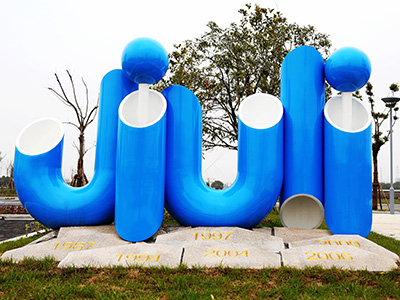The forms of metal corrosion can be divided into general (uniform) corrosion and local corrosion. The former occurs more uniformly on the whole surface, while the latter only occurs locally. For example, pore corrosion, crevice corrosion, intergranular corrosion, stress corrosion cracking, corrosion fatigue, hydrogen corrosion cracking, selective corrosion, wear corrosion, delamination corrosion, etc.
Generally, local corrosion is much more serious than general corrosion, and some local corrosion is often sudden and catastrophic. Such as equipment and pipe perforation rupture caused by flammable explosion or toxic fluid leakage, and cause fire, explosion, environmental pollution and other accidents. According to some statistics, the corrosion of chemical equipment, local corrosion accounts for about 70%. Uniform corrosion is less dangerous, but a large number of metals are exposed to the gas and water that produce uniform corrosion, so the economic loss is also very serious.
Comprehensive (uniform) corrosion: refers to all or most of the metal surface corrosion, corrosion degree is roughly uniform. Generally, the surface is covered with a layer of corrosion product film, which can slow down the corrosion. High temperature oxidation is an example. And easy to passivate metals such as stainless steel, titanium, aluminum, etc. in the oxidizing environment to produce a very thin passivating film, has excellent protection, so that the corrosion essentially stopped. The oxidation film (rust) produced by iron in the atmosphere and water is very low protection. Generally the uniform corrosion is very serious.
Pore corrosion: a highly local form of corrosion. Most of the metal surface is not corroded or corroded slightly, with only one or a few holes occurring locally. The hole has a large size, the general hole surface diameter is equal to or less than the hole depth, but there are also pit shaped shallow dish hole. Small and deep holes can make the metal plate penetrate, causing fluid leakage, fire, explosion and other accidents, it is one of the most destructive and hidden corrosion forms.
Crevice corrosion: a special form of pitting corrosion that occurs in crevices (such as cracks under welding, riveting joints, gaskets or sediments). The damage form is grooves and crevices. Severe penetrability. In the gap, there is anoxic area, which is also in the occlusion state. The pH value in the gap decreases, and the chloride ion concentration increases. There is often a long incubation period, when the pH value in the seam drops to a critical value, similar to the pore, also produces accelerated corrosion. Generally, it is most likely to occur in the solution containing chloride ions, and the effective method to prevent it is to eliminate the gap.
Declamination corrosion: corrosion between layers of a metal structure that develops vertically inward and then changes direction to selectively corrode substances parallel to the surface. The expansive force of the corrosion product causes the uncorroded surface layer to dissociate in layers.
Intergranular corrosion: corrosion develops inward from the surface along the grain boundary. There is no sign of corrosion on the surface, but loose corrosion products are deposited at the grain boundary. Metallographic microscope showed that the grain boundaries presented network corrosion. Severe intergranular corrosion can cause metals to lose strength and ductility and to fragment under normal load.
Selective corrosion: industrial alloys contain different components and impurities, have different structures, corrosion resistance is also different. In a given solution, some active components are dissolved, leaving loose inactive components, strength and ductility are completely lost. A common example of this type of selective corrosion is the removal of zinc from brass.
Wear corrosion: metal surface by high velocity and turbulent fluid impact, wear and corrosion at the same time, called wear corrosion. Impact corrosion is the main form of wear corrosion, in addition to cavitation corrosion and friction corrosion.
Stress corrosion cracking: alloys under the action of corrosion and tensile stress in a certain direction at the same time, called stress corrosion cracking. There are two kinds of fracture morphology: along grain boundary direction, called intergranular fracture; When the crack passes through the grain, it is called transgranular fracture. There are also mixed types, such as the main slit is intercrystalline, branch slit or tip is transcrystalline, it is one of the most dangerous corrosion forms, can cause sudden accidents.
Corrosion fatigue: corrosion and alternating stress (periodic change in the direction of stress, also known as the periodic stress) caused by the joint action of fracture, known as corrosion fatigue. Corrosion fatigue occurs most easily in environments where pitting can occur.
Hydrogen corrosion: including hydrogen bubbling and hydrogen embrittlement. Hydrogen bubble: in low strength steel, especially containing large amounts of non-metallic inclusions, produce hydrogen atoms can easily spread to the metal in the solution, combining to the wall on the other side the most H for H2 escape, but there is a small amount of H followed in steel hole, combination of H2, because hydrogen molecules cannot spread, will accumulate a huge internal pressure, the steel surface bubble, even burst; Hydrogen embrittlement: the crystal lattice is highly deformed in high strength steel. When H enters, the crystal lattice should be enlarged, which reduces toughness and ductility, resulting in embrittlement and rupture under external force.


















